|
Way back when I first got into art school, before we'd been introduced to the wonders of the movements that had shaped twentieth century painting and sculpture, our art history teacher eased us in by discussing a few of the works that he figured we'd all heard of. High on the list was Leonardo da Vinci's universally recognised portrait painting, Mona Lisa, of which he was dismissive in a way that surprised us all. "I went to the Louvre in Paris," he told us, "waited my turn to look at it, then shrugged and moved on." A few years later, by when my art education had been considerably expanded, I likewise visited the Louvre, stood in line and got my allotted couple of minutes in front of the painting, which by then was encased in a glass-fronted cabinet to protect it from art terrorists and ambitious thieves. The thing that struck me most about it, I seem to remember, was that it was smaller than I had expected, but like my art history lecturer I was otherwise unmoved. Then again, by this point I'd discovered and fallen for the more modernist wonders of Impressionism, Futurism, Dada, The Bauhaus, Surrealism, Abstract Expressionism and the like.
But even allowing for this, the particular allure of this most famous of portraits continues to elude me. I do, however, appreciate its lasting cultural impact and the mesmerising effect it appears to have on others, who talk enthusiastically of the subject's enigmatic smile and eyes they claim will follow you wherever you walk, an illusion also true of many decently rendered portraits. But it's that perceived enigma that makes the painting a still potent reference point, one that you can't help but suspect was instrumental on director Neil Jordan's choice of title for his 1986 film of the same name. Consider this from the publicity blurb of the time: "Mona Lisa is a film about a song, about a painting, about a woman; about men, and the images they make of women, the stories they need do tell themselves, to keep them mystic, unfathomable, anything but real." On his commentary track on this very disc, Jordan has a slightly different take, suggesting that the title was shaped in part by the painting's status as "this piece of art that to everybody represents the cheapest form of aestheticism." Mix those two together and you've got the basis for an interesting film. Mona Lisa happens to be somewhat more than that.
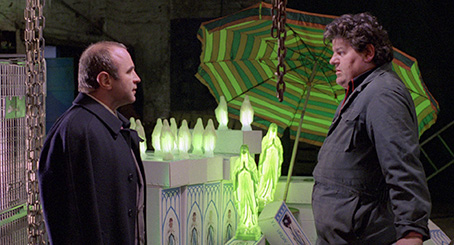
The central character is George, a small-time crook who has just been released from prison after twelve years banged up for an unspecified crime. He's played by Bob Hoskins in what was easily his best role since his blistering breakthrough as London gangster Harold Shand in The Long Good Friday. There are, inevitably, echoes of that film here (both are set in gangland London after all), but also crucial differences that are evident from the start. It's all laid out in that way Hoskins walks. Whereas the cocksure authority of his introductory stride through Heathrow airport in The Long Good Friday established his position as the leader of London's largest criminal gang in a matter of seconds, his opening title walk across the Thames at the start of Mona Lisa tells a very different story. Scuttling forward as if just a little late for an appointment, looking uncertainly around him and clutching a parcel in a manner that almost suggests he expects someone to rush up and try to steal it, he's an isolated figure who no longer seems to recognise the city he grew up in. He's emerged from prison as a stranger in his own land and is looking to try and put his old life back together. It's not going to happen. His teenage daughter intially fails to recognise him and his furious wife won't let him through the front door. When she slams that very door in his face, his anger is redirected at the crowd that has assembled outside of what was once his front gate. He's saved from a probable beating by the arrival of his old friend, cheerful mechanic and wheeler-dealer Thomas, played by rotund comedian (and later dramatic actor of note in Jimmy McGovern's Cracker) Robbie Coltrane.
In need of regular work, George seeks out gangland kingpin Mortwell (Michael Caine), who apparently owes him a serious favour. We never find out for what. Unusually, there are no back story details provided here, and the hints that are dropped are so mysteriously opaque – George stops off to buy a white rabbit for Mortwell, something we're clearly meant to read as significant – that even Sherlock Holmes would struggle to fill in the details. It turns out that Mortwell is out of the country, but one of his equally grubby lieutenants Dudley (familiar face Joe Brown in what is virtually a cameo) hires George to drive high class black prostitute Simone (Cathy Tyson) to meet her well-to-do clients. George and Simone are at loggerheads from the moment they meet, fuelled in part by a naiveté on George's part that borders on childlike innocence and stoked by Simone's dismay at her new driver's lack of awareness and class. "Where did they get you from?" she snaps in frustration after he bungles escorting her out of a plush hotel on their first meeting, which prompts the snarled response, "Under a cabbage leaf!"

The conflict between them springs initially from misperceptions of status on both sides. Simone may have started on the streets, but she's since moved up the social ladder and now services rich men at their mansion houses or in rooms at expensive hotels. It's a status shift within her profession that requires her to project an image of elegance and sophistication, one that she believes will be compromised by the very visible lack of both qualities in George. He, on the other hand, is an old school bigot whose prejudices have been time-capsuled by his time in prison and who has been left a little bemused by the changes the world around him has undergone in his absence. Simone's airs and graces mean little to a man who at the outset defines her by her profession and skin colour and who thus regards himself as socially superior by default. His rejection of her early attempts to shape his image is not fuelled by pride but his irritation at the idea that someone he believes is beneath him is trying to tell him how to dress and to conduct himself.
This mutual lack of understanding peaks after Simone gives George money to buy clothes more befitting his role as her companion, and instead of procuring the hoped-for smart suit he kits himself out like a 1970s disco dad. Simone is furious, aghast at his lack of taste and the attention it draws to her when she is supposed to be working incognito. "I may as well be wearing a sign around my neck." she tells him. "All you're missing is the gold medallion!" "You don't like them either?" George wearily responds, pulling one out from beneath his shirt. A short while later the argument explodes and George pulls Simone from the car and dares her to fire him. Simone obliges. "Lovely," George barks back. "I'm fired, and you're streetwalking!"
This explosion of anger proves to be a tipping point for change for both parties, as George regrets his outburst and the small steps of conciliatory progress made in the early stages evolve into more confident strides. The two get to know and even like each other, a gradual change in the nature of their relationship that is outlined by George in his chats with Thomas as if summarising the plot of a novel he is currently reading, one in which Simone is first dismissed as "a tall, thin, black tart" but is later more respectfully referred to as "a lady."
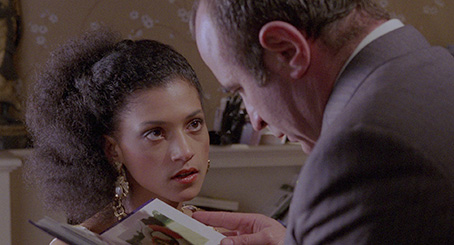
As their bond of trust grows, Simone asks George to help her locate a young girl named Cathy with whom she once worked the streets and who has now disappeared. His search takes George into the bowels of London's seedy underworld but brings him closer to Simone, on whom he begins to project his own idealised impression of who she might be. A little like so many do with a certain painting, in fact. In doing so, George effectively blinkers himself to a truth that is not even on his traditionalist radar, and sets himself up for a serious emotional fall. The clues, ironically, are laid out early by Simone when George asks her if any of her clients fall in love with her, to which she tellingly replies, "Sometimes they fall for what they think I am."
Despite the considerable tonal differences between the two films, it's hard to ignore the influence of Martin Scorsese's seminal Taxi Driver on Mona Lisa, a film that curiously gets not a single mention in the on-disc extra features. That there are similarities in the storyline – like Travis Bickle, George eventually takes action to rescue a young prostitute from the seedy underworld in which she is trapped – could well be coincidental, but the parallels extend to imagery that directly mirrors some of that in Scorsese's film: the telling, sometimes hallucinatory use of the car's rear view mirror to reflect the eyes or face of the driver or passenger; the bridge on which prostitutes openly conduct their business that feels every bit as Dante-esque as Travis's hellish view of New York; the camera that is locked onto elements of the car bodywork as the vehicle prowls the streets or flees from the bridge; a climactic act of violence involving a handgun, a pimp, a young prostitute and a gangster. There's even a sequence that plays out almost exactly as it does in its Taxi Driver equivalent, when in the course of his search George visits an under-age prostitute, refuses her advances, gives money to her pimp as he leaves, and on being invited to come back any time makes a sinister promise to do just that. Even his exit from the scene down a flight of dimly lit stairs architecturally echoes the earlier film.
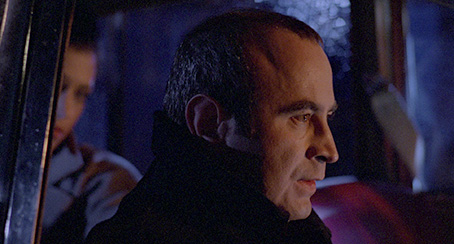
But strangely enough, this never matters a jot. Unlike the handful of films that have attempted to rework Taxi Driver to their own ends – the 2004 Singapore drama Perth comes readily to mind – for Mona Lisa these are merely visual and thematic touchstones that ultimately emphasise the substantial differences between the two movies. We are clued into this by the opening title music, with the dark and almost militaristic menace of Bernard Herrmann's main theme for Scorsese's film replaced here with the dulcet voice of Nat King Cole crooning the title song, a romantic tune that repeatedly resurfaces in variously modified form to subtly underscore the softening of relations between George and Simone. These differences extend to the respective films' leading men. Both Travis and George are essentially lonely men with a simplistic and bigoted view of the cities in which they live, but while Travis is a ball of inarticulate and destructive fury just waiting to explode, George's small bursts of anger spring largely from his lack of understanding of how the world has changed during his time in the nick. And while Travis prepares for war, George goes through a gradual awakening, one that sees his hard edges soften and a genuine tenderness rise to the surface. Travis is a essentially a monster of our intolerant id, while George is a romantic with an idealised view of how the world should be, one that's destined to be shattered when his fairy tale bubble collides with reality.
The evolving friendship between George and Simone is the heart of the film and is beautifully developed, a harmonious blend of spot-on scripting, precision direction and two perfectly pitched central performances from Bob Hoskins and Cathy Tyson as George and Simone. This is Hoskins at his Long Good Friday best, but in the process of revealing George's emotional vulnerability, I'd risk suggesting that it's an even more complex and layered portrayal than his career-defining tour-de-force as Harold Shand. Every moment of his performance here is noteworthy, never more so than in the later scenes when the truth about his relationship with Simone really starts to hit home.
Despite this being her first film role, Cathy Tyson is every bit Hoskins' equal in what must have been a hell of a balancing act, one that required her to exude a degree of sophistication and authority and convince us that both are an integral elements of a profession with which we tend to associate neither quality. What really sells her friendship with George as real is the increasingly seductive chemistry between the two characters (and by inference, actors), one that prompts us to feel deeply for both and fear for them when – in the film's most heart-stopping moment – Simone's former pimp appears out of nowhere and attacks the pair with a cut-throat razor. And while his screen time may be limited, Michael Caine clearly relishes the role of sleazy gangland porn king Mortwell; his gut bulging unflatteringly over his belt, he towers intimidatingly over Hoskins and angrily berates him in a way that seems to reduce his shorter companion even further in size.
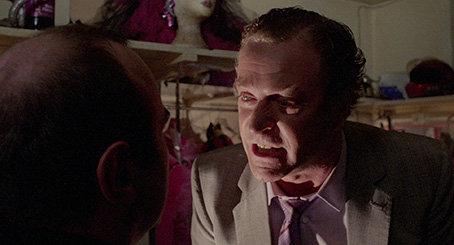
Coming back to Mona Lisa after so many years I was particularly stricken by how complete a film it seems, one whose writing, characters, performances, direction and richly layered narrative all effortlessly meld into a unified and deeply satisfying whole. It remains for me one of the films I'd show to any poor fool who still wonders why we hold the late, great Bob Hoskins in such high regard, and is still to this day one of my very favourite works by the frustratingly unpredictable Neil Jordan. That an actress of Cathy Tyson's talent found herself largely confined to TV roles in subsequent years probably says a lot about a continued paucity of decent leading roles for black actresses in modern western cinema, though two years later she did co-star in Wes Craven's undervalued voodoo horror The Serpent and the Rainbow, which over the years has developed a bit of a cult following. That she, Hoskins, Caine and an impressive supporting cast are all at pretty much the top of their game here is a testament to the material with which they were able to work and the still fresh instincts of their then young and talented director.
The transfer here is a 2K restoration made from the original camera negative, carried out at Deluxe Restoration in London under the supervision of director Neil Jordan and director of photography Roger Pratt, with the project itself supervised by James White exclusively for Arrow Films. Based on previous restorations carried out by Deluxe for Arrow, I could just leave my comments at that and you'll probably have a good idea of just how lovely it looks. If I had Robocop's ability to replay my memory like a video recording I could make comparisons with how the film looked when I saw in the cinema years ago, but frankly I'd be surprised if it was any better than this. The contrast is beautifully balanced, nailing the black levels but without sucking in detail in darker areas (except when intended), particularly important given how much of the film takes place at night. This is exemplified by an exterior night shot of the Ritz Restaurant with George's Jaguar parked outside at 0:17:14 – the restaurant's name is spelt out in light bulbs, the pavement and doorways are lit and the street is in shadow, and yet the black levels are solid, there are no burn-outs on the bulbs, and detail is clearly visible on every part of the image. And there is plenty of detail to see – the picture is often scalpel sharp, and despite George's car being framed wide in this shot and viewed almost (but not quite) side on, I could read just about every character on its number plate (the last two are just too close together to make out at this angle). The colour rendition is particularly pleasing, the naturalistic tones occasionally joined by more vivid colours in the Soho clubs and shop front windows. The picture, as you would hope, is virtually spotless and free of any jitter or obvious damage. Film grain is visible, but unobtrusive and natural looking. A gloriously good transfer.
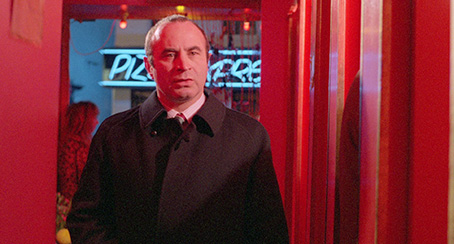
The Linear PCM 2.0 track is also in excellent shape, with clear reproduction of dialogue, no obvious issues and a strong dynamic range whose quality can best be measured when the Genesis track kicks in – I've heard music on the soundtracks of more recent films that didn't have the crisp and beefy audio quality on display here.
Optional SDH English subtitles are also available.
Commentary by Neil Jordan and Bob Hoskins
I can't say for sure, but I have a suspicion that this commentary may have been licensed from Criterion's US release of the film (feel free to correct me if not), which also features a commentary with Jordan and Hoskins. It's certainly been assembled in the favoured Criterion manner, with the director and actor recorded separately and their comments then edited together, though it does appear that Jordan was watching the film during this process and that Hoskins was not. I'm not complaining, as it's absolutely loaded with worthwhile information and anecdotes relating to the film and its production. Jordan's in the driving seat, so to speak, and discusses working with the actors, his original plan to cast Sean Connery as George and how the script changed when Bob Hoskins was cast instead, the relish with which Michael Caine played his bad guy role, the small battle he had with producer Denis O'Brien that led to a compromise use of In Too Deep by Genesis over a montage that was designed to be somewhat darker in tone (a decision he's still not happy with), executive producer George Harrison's insistence that there be no naked dicks in the movie (seriously), and a whole lot more. Hoskins chips when his own recollections are relevant to the scene under examination and is equally revealing, particularly about working with Cathy Tyson, and there's a nice little story about Anthony Hopkins unexpectedly showing up on the first day of shooting just to wish him luck. Both he and Jordan analyse the character of George and his emotional journey in considerable detail, and there's something wonderfully self-depreciating about Hoskins' description of himself as "five foot six, cubic with the face of a Brussels sprout." An essential extra.
Interview with Neil Jordan (19:56)
The softly spoken Jordan recalls how the film came to be and provides a compact version of its development from David Leland's first draft to the finished film, which they were able to make with next to no interference because the producers were tied up on Julien Temple's musical extravaganza Absolute Beginners. He talks about the casting (and claims Caine was cast after Hoskins, which jars a little with something said in David Leland's interview below), reveals that he wanted to make a film about the way in which men misunderstand women, and reflects on its reception and a couple of things he is not completely happy with now. He also describes Hoskins' performance as "the beating heart of the film." Nice.
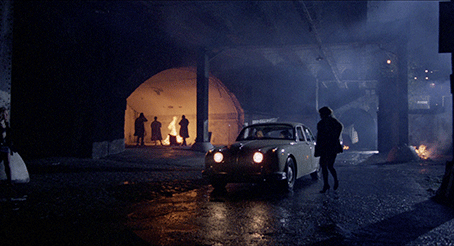
Interview with Stephen Woolley (13:35)
An interesting interview with producer, Palace Pictures guru and former manager of the Scala cinema in London (which is how I personally remember him) Stephen Woolley, who recalls the film's inception and development, and reflects on how it represents Neil Jordan's view of London and remains a snapshot of a time that has long since passed. The camera operator here seems to have set themself a challenge to get the full interview nailed before a shifting beam of sunlight hits Woolley full in the face (it never does), and a couple of times where the light level drops and briefly casts him in shadow feel almost like accidental nods to the film's noir elements. Am I reading too much into this?
Interview with David Leland (18:59)
Co-screenwriter David Leland is interviewed in his garden about his work on the film and outlines how the process of writing took place, with him creating a first draft and Neil Jordan then re-writing it, something both men had agreed on from the start. He contradicts Jordan by claiming that the role of George was originally intended for Michael Caine and that he wrote his draft with that actor in mind, but believes the casting of Hoskins was the making of the film. He also reveals where he first saw Hoskins act (this is interesting) and selects his favourite scenes from the finished film.
Theatrical Trailer (2:31)
Despite the soothing voice of Nat King Cole on the soundtrack, the trailer initially goes out of its way to cement the Taxi Driver connection, then tries to sell it as a sinister thriller. Way to go.
Booklet
The centrepiece here is an interesting essay on the film by Mark Sutton, which does acknowledge the Taxi Driver influence, though perhaps not the extent to which it is visible. Also included are credits for the film and notes on the restoration.
A fine showcase for the acting metal of all involved and Neil Jordan's talents as both writer and director (and let's not forget the work of the redoubtable David Leland, who laid the film's foundations), beautifully restored here and coupled with a handful of choice extra features. If you've not picked up Arrow's limited edition box set that packages this disc with The Long Good Friday and includes another disc of extras unique to that release, then put this on your shopping list pronto. Highly recommended.
|